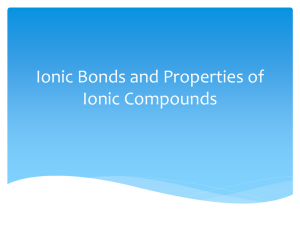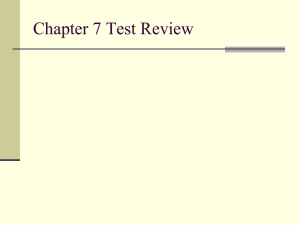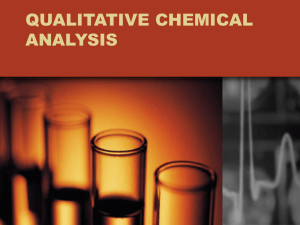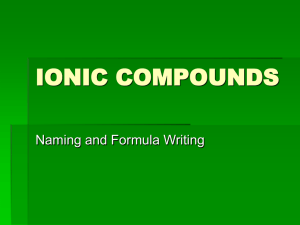Solubility Rules Lab Document
advertisement
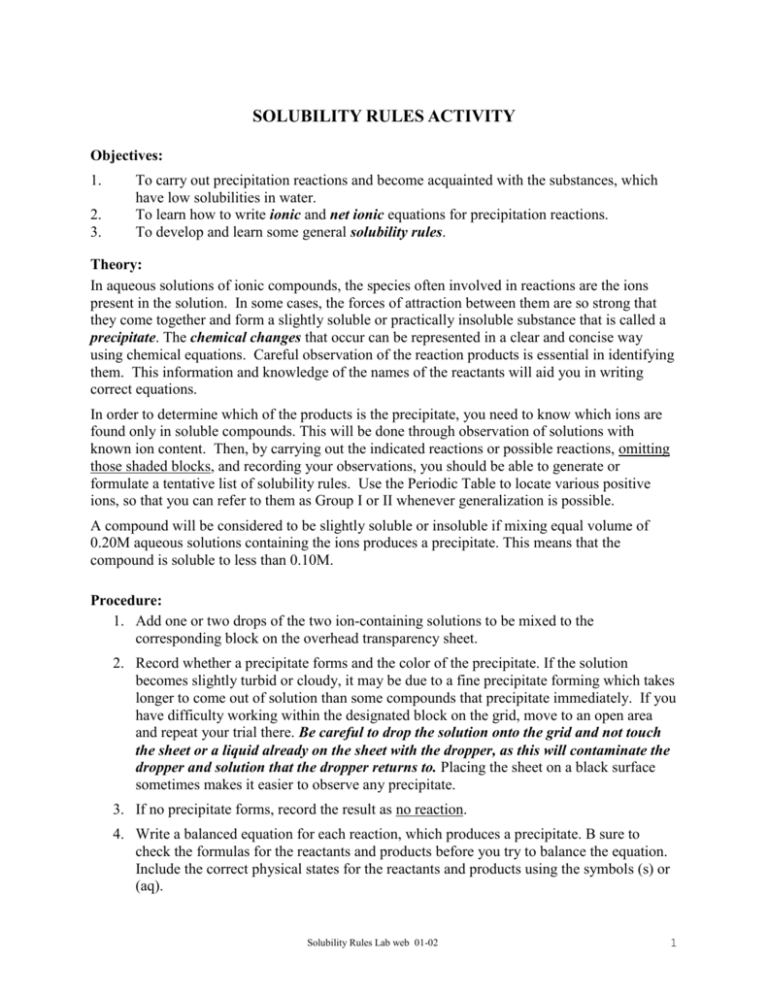
SOLUBILITY RULES ACTIVITY Objectives: 1. 2. 3. To carry out precipitation reactions and become acquainted with the substances, which have low solubilities in water. To learn how to write ionic and net ionic equations for precipitation reactions. To develop and learn some general solubility rules. Theory: In aqueous solutions of ionic compounds, the species often involved in reactions are the ions present in the solution. In some cases, the forces of attraction between them are so strong that they come together and form a slightly soluble or practically insoluble substance that is called a precipitate. The chemical changes that occur can be represented in a clear and concise way using chemical equations. Careful observation of the reaction products is essential in identifying them. This information and knowledge of the names of the reactants will aid you in writing correct equations. In order to determine which of the products is the precipitate, you need to know which ions are found only in soluble compounds. This will be done through observation of solutions with known ion content. Then, by carrying out the indicated reactions or possible reactions, omitting those shaded blocks, and recording your observations, you should be able to generate or formulate a tentative list of solubility rules. Use the Periodic Table to locate various positive ions, so that you can refer to them as Group I or II whenever generalization is possible. A compound will be considered to be slightly soluble or insoluble if mixing equal volume of 0.20M aqueous solutions containing the ions produces a precipitate. This means that the compound is soluble to less than 0.10M. Procedure: 1. Add one or two drops of the two ion-containing solutions to be mixed to the corresponding block on the overhead transparency sheet. 2. Record whether a precipitate forms and the color of the precipitate. If the solution becomes slightly turbid or cloudy, it may be due to a fine precipitate forming which takes longer to come out of solution than some compounds that precipitate immediately. If you have difficulty working within the designated block on the grid, move to an open area and repeat your trial there. Be careful to drop the solution onto the grid and not touch the sheet or a liquid already on the sheet with the dropper, as this will contaminate the dropper and solution that the dropper returns to. Placing the sheet on a black surface sometimes makes it easier to observe any precipitate. 3. If no precipitate forms, record the result as no reaction. 4. Write a balanced equation for each reaction, which produces a precipitate. B sure to check the formulas for the reactants and products before you try to balance the equation. Include the correct physical states for the reactants and products using the symbols (s) or (aq). Solubility Rules Lab web 01-02 1 5. Write net ionic equations for each reaction observed. To write the net ionic equation, it may be easier to start with the balanced overall equation and separate any water-soluble compounds, the ones in aqueous solution, into their ions. Solids, liquids, and gases are not dissociated. The ions, which have not undergone any change, are called spectator ions and can be cancelled from both sides of the equation. This produces the net ionic equation. Example: Aqueous solutions of NaI and Pb(NO3)2 are mixed. A precipitate forms. You have observed that compounds containing Na+1 ions and those containing NO3-1 ions are water-soluble therefore the precipitate must be PbI2 as indicated by (s) in the equation. The combination of the Na+1 ion and the NO3-1 ion produces an aqueous solution of NaNO3 since this compound is water-soluble. Balanced Overall Equation: Pb(NO3)2 (aq) + 2 NaI (aq) PbI2 (s) + 2 NaNO3 (aq) Overall Ionic Equation: Pb+2(aq) + 2 NO3-1 (aq) + 2 Na+1(aq) + 2 I-1 (aq) PbI2 (s) + 2 Na+1(aq) + 2 NO3-1 (aq) Spectator Ions: Na+1(aq) and NO3-1 (aq) Net Ionic Equation: Pb+2(aq) + 2 I-1 (aq) PbI2 (s) Note that the ions that appear in the net ionic equation for a precipitation reaction are the ions that form the precipitate. These are the ions, which are undergoing a change. Solubility Rules Lab web 01-02 2 SOLUBILITY RULES ACTIVITY Name: ______________________________________________ Period:_________ Lab Partner: _________________________________________ Date: __________ POST LAB QUESTIONS To summarize your results, answer the questions which follow using: SOLUBLE or INSOLUBLE. 1. In general, all compounds containing ions from Group I of the Periodic Table are ___________________. 2. In general, all compounds containing NH4+ ions are _________________. 3. In general, all compounds containing NO3- ions are ___________________. 4. In general, compounds containing Cl-, Br-, and I- ions are _________________ except those containing these positive ions______________________. 5. In general, compounds containing F- ions are _________________ except those containing these positive ions ________________. 6. In general, compounds containing SO4-2 ions are soluble except those containing these positive ions ________________. 7. In general, compounds containing S-2 ions are insoluble except those containing these positive ions ________________. 8. In general, most compounds containing OH-1 ions are _________________ except compounds containing these positive ions ___________and Group ___ of the Periodic Table. 9. In general, most compounds containing CO3-2 or PO4-3 ions are ___________. except compounds containing the positive ions ____________ and Group ___ of the Periodic Table. Solubility Rules Lab web 01-02 3 F- Cl- Br- I- OH- SO4-2 CO3-2 S-2 PO4-3 NaF NaCl NaBr NaI NaOH Na2SO4 Na2CO3 Na2S Na3PO4 Ag+ AgNO3 NH4+ NH4NO3 Mg+2 Mg(NO3)2 Ca+2 Ca(NO3)2 Sr+2 Sr(NO3)2 Ba+2 Ba(NO3)2 Zn+2 Zn(NO3)2 Cu+2 Cu(NO3)2 Al+3 Al(NO3)3 Pb+2 Pb(NO3)2 Fe+3 Fe(NO3)3 Solubility Rules Lab web 01-02 4 Solubility Rules Lab web 01-02 5




